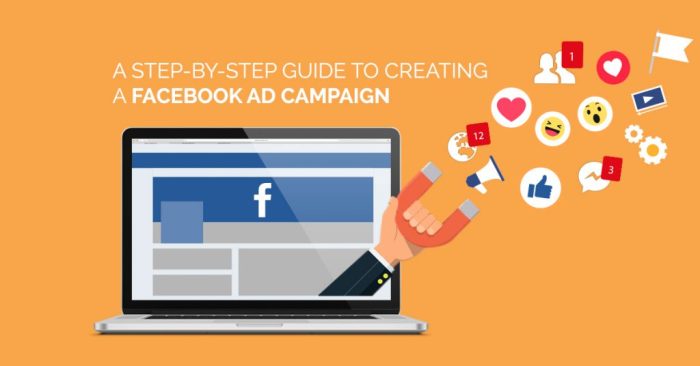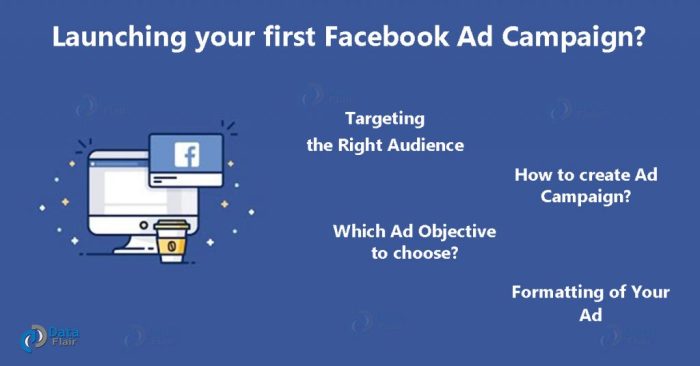Developing Facebook Ad Campaigns takes center stage, inviting readers into a world of social media marketing. Get ready for a deep dive into the art of creating effective ad campaigns on the popular platform.
From understanding the basics to optimizing performance, this guide will equip you with the knowledge needed to run successful Facebook ad campaigns.
Understanding Facebook Ad Campaigns

When it comes to Facebook ad campaigns, it’s all about getting your message out to the right audience at the right time. These campaigns allow businesses to promote their products or services to a targeted group of people on Facebook.
Types of Facebook Ad Campaigns
- 1. Awareness Campaigns: These campaigns are designed to increase brand awareness and reach a larger audience.
- 2. Consideration Campaigns: These campaigns aim to get people to engage with the content, visit a website, or interact with the brand in some way.
- 3. Conversion Campaigns: These campaigns focus on driving specific actions such as making a purchase or signing up for a newsletter.
Setting Clear Campaign Objectives
It’s crucial to set clear objectives for your Facebook ad campaigns. Whether you’re looking to increase sales, generate leads, or drive website traffic, having defined goals will help you measure the success of your campaigns.
Defining Target Audiences
- 1. Use Facebook’s Audience Insights tool to gather data on your target audience’s demographics, interests, and behaviors.
- 2. Create audience personas based on this data to tailor your ad campaigns to resonate with specific groups of people.
- 3. Refine your target audience by testing different demographics, interests, and behaviors to see what works best for your campaigns.
Creating Compelling Ad Content

Creating compelling ad content is crucial for the success of your Facebook ad campaigns. From engaging copy to eye-catching visuals, every element plays a vital role in capturing the attention of your target audience and driving conversions.
Elements of a Successful Facebook Ad
- Clear and concise messaging: Your ad copy should be easy to understand and highlight the benefits of your product or service.
- Eye-catching visuals: Use high-quality images or videos that grab the viewer’s attention and are relevant to your message.
- Strong call-to-action: Encourage viewers to take a specific action, whether it’s to learn more, shop now, or sign up.
- Relevance: Ensure that your ad content is tailored to your target audience’s interests, demographics, and behaviors.
Tips for Creating Engaging Ad Copy and Visuals
- Use storytelling: Create a narrative that resonates with your audience and makes them connect emotionally with your brand.
- Highlight benefits: Focus on how your product or service can solve a problem or improve your audience’s life.
- Keep it concise: Use short and impactful sentences that are easy to read and understand quickly.
- Include social proof: Incorporate testimonials, reviews, or endorsements to build trust with potential customers.
Importance of A/B Testing Ad Content
A/B testing allows you to experiment with different versions of your ad content to see which performs better. By testing variables like copy, visuals, and calls-to-action, you can optimize your ads for higher click-through rates and conversions.
Strategies for Aligning Ad Content with Campaign Goals
- Set clear objectives: Define what you want to achieve with your ad campaign, whether it’s brand awareness, lead generation, or sales.
- Tailor content to goals: Ensure that your ad content directly supports your campaign objectives and drives the desired action from your audience.
- Monitor performance: Regularly analyze the results of your ads to see if they are aligning with your goals, and make adjustments as needed.
Setting Up Ad Campaigns on Facebook: Developing Facebook Ad Campaigns
To set up a successful Facebook ad campaign, you need to follow a step-by-step process that involves choosing the right campaign objective, setting a budget, selecting targeting options, and monitoring performance.
Choosing the Right Campaign Objective
- Start by identifying your specific goals for the ad campaign, whether it’s increasing brand awareness, driving traffic to your website, generating leads, or boosting sales.
- Based on your goals, select the most appropriate campaign objective from options like brand awareness, reach, traffic, engagement, app installs, lead generation, conversions, and more.
- Each objective is designed to optimize your ad delivery for the desired outcome, so make sure to choose the one that aligns best with your goals.
Budgeting and Bidding Strategies
- Determine your budget for the ad campaign, considering factors like duration, audience size, and overall marketing goals.
- Choose between a daily or lifetime budget, depending on how you want to allocate your ad spend.
- Set your bid strategy based on your objectives, whether it’s maximizing link clicks, impressions, or conversions.
- Consider using automatic bidding to let Facebook optimize your bids for the best results within your budget.
Targeting Options on Facebook Ads Manager, Developing Facebook Ad Campaigns
- Utilize Facebook’s detailed targeting options to reach specific audiences based on demographics, interests, behaviors, and more.
- Explore custom audiences to retarget existing customers or lookalike audiences to reach new users similar to your current customer base.
- Take advantage of advanced targeting features like location targeting, device targeting, and connection targeting to refine your audience even further.
Monitoring and Optimizing Ad Performance
Monitoring and optimizing ad performance is crucial in ensuring the success of your Facebook ad campaigns. By tracking key metrics, analyzing data, and making necessary adjustments, you can improve the effectiveness of your ads and reach your target audience more efficiently.
Tracking Ad Performance Metrics
- Monitor metrics such as click-through rate (CTR), conversion rate, cost per click (CPC), and return on ad spend (ROAS) to gauge the performance of your ads.
- Use Facebook Ads Manager to track these metrics in real-time and gain insights into how your ads are performing.
- Set up custom reports to focus on specific metrics that align with your campaign goals and objectives.
Analyzing Data for Optimization
- Regularly analyze the data collected from your ad campaigns to identify trends, patterns, and areas for improvement.
- Look for demographic insights, ad placements that perform well, and the impact of different ad creatives on audience engagement.
- Use A/B testing to compare different ad variations and determine which ones resonate best with your target audience.
Split Testing Ad Variations
- Create multiple versions of your ad with variations in copy, imagery, or calls-to-action to see which performs best.
- Run split tests with a controlled audience to measure the impact of each variation on key metrics.
- Optimize your ads based on the results of split tests to improve overall performance and maximize your return on investment.
Adjusting Ad Campaigns Based on Performance Insights
- Use the data and insights gathered from tracking ad performance metrics to make informed decisions about adjusting your ad campaigns.
- Consider reallocating budget to top-performing ads, pausing underperforming ads, or testing new audience targeting options.
- Regularly review and optimize your ad campaigns to ensure they are meeting your goals and driving the desired results.
